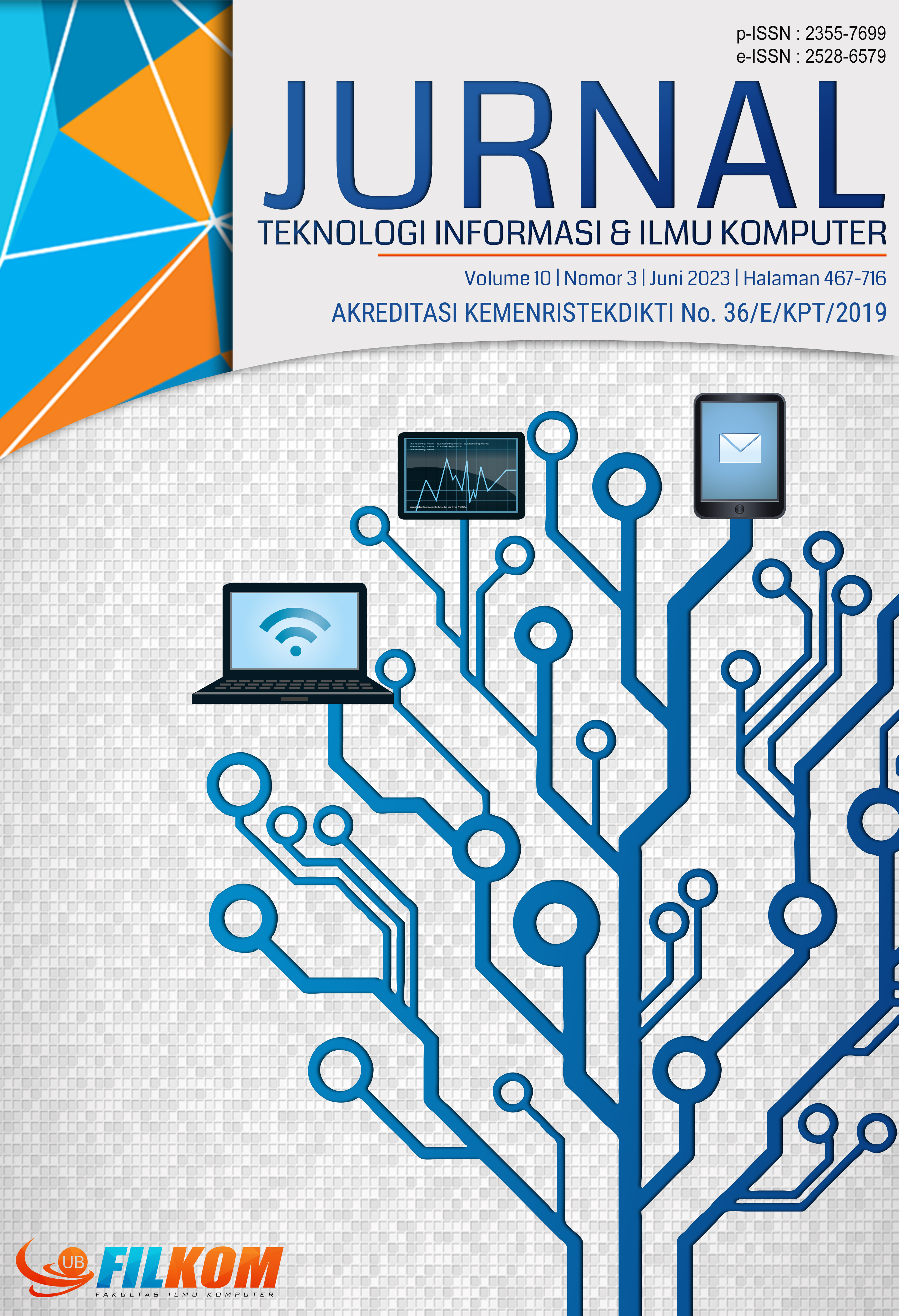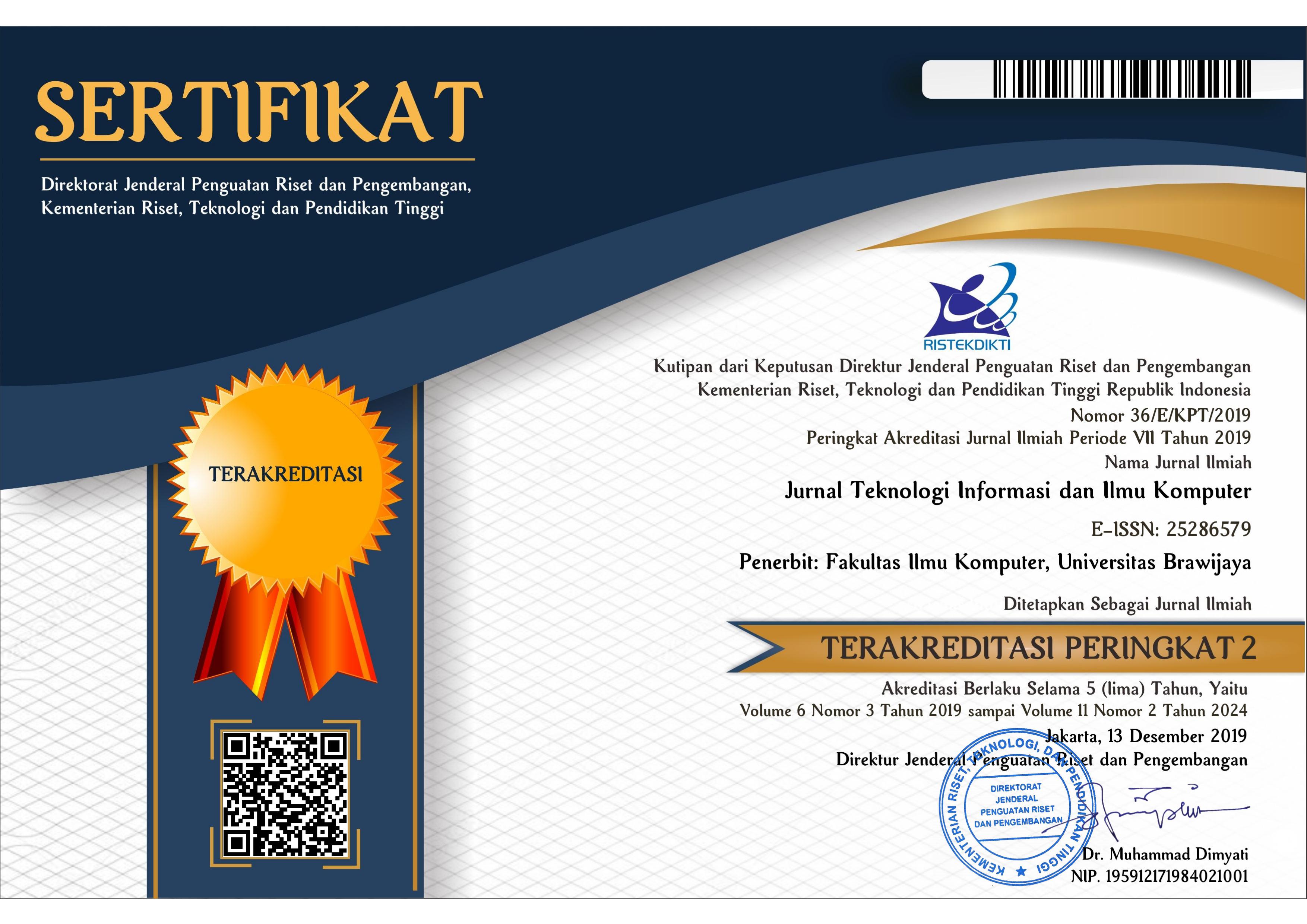Implementasi Algoritma BFCC dan kNN pada Embedded System untuk Deteksi Dini Bronchitis
DOI:
https://doi.org/10.25126/jtiik.2023106571Abstrak
World Health Organization (WHO) menyatakan bahwa sebanyak 600 juta orang di dunia menderita bronchitis. Bronchitis merupakan salah satu penyakit pernafasan yang dapat disebabkan oleh virus Respiratory Syncitial Virus (RSV) dan Rhinovirus. Gejala umum bronchitis adalah seseorang akan mengalami kesulitan bernafas dengan disertai batuk. Namun, tidak sedikit orang mengabaikan gejala umum ini sehingga berindikasi mengalami bronchitis tingkat berat ataupun berpotensi kematian. Oleh karena itu, dalam paper ini mengusulkan sistem deteksi dini bronchitis berdasarkan suara batuk berbasis embedded system. Ini merupakan terobosan baru pada dunia medis dengan desain alat kesehatan yang portabel. Sistem yang diusulkan menerapkan algoritma Bark Frequency Cepstral Coefficients (BFCC) dan K- Nearest Neighbor (kNN). BFCC merupakan algoritma yang digunakan untuk mengekstraksi fitur suara batuk dan menghasilkan nilai koefisien cepstral. Selanjutnya, nilai koefisien cepstral tersebut dihitung jarak Euclidean-nya untuk dapat diklasifikasikan menggunakan kNN. Algoritma BFCC dan kNN diimplementasikan pada perangkat Mini Komputer Raspberry Pi 3 Model B+ dengan mikrofon sebagai perangkat masukan suara dan perangkat LCD touchscreen 3.5 inchi untuk sebagai antarmuka yang menampilkan keluaran hasil deteksi. Hasil pengujian menunjukkan rata-rata waktu komputasi sebesar 4,452 detik dan penggunaan CPU sebesar 26%, serta akurasi kNN sebesar 73% untuk perhitungan jarak Euclidean dengan nilai neighbour = 5.
Abstract
The World Health Organization (WHO) states that as many as 600 million people in the world suffer from bronchitis. Bronchitis is a disease that can be caused by respiratory syncytial virus (RSV) and rhinovirus. Symptoms of common bronchitis a person will experience difficulty breathing accompanied by coughing. Unfortunately, many people underestimate this common symptom. Even though, it is indicating that they have severe bronchitis or possibly death. Therefore, this study proposes an early detection system for bronchitis based on cough e sounds based on an embedded system. This is a new breakthrough in the medical world with a portable medical device design. The proposed system applied the Bark Frequency Cepstral Coefficients (BFCC) and K-Nearest Neighbor (kNN) algorithms. BFCC is an algorithm that is used to extract cough sound features and produce cepstral coefficient values. Furthermore, the value of the cepstral coefficient will be calculated for the Euclidean distance to be classified using kNN. The implementation of the BFCC and kNN algorithms is carried out on a Raspberry Pi 3 Mini Computer Model B+ with a microphone as a voice input device and a 3.5-inch LCD touchscreen device to display the resulting output interface. The results obtained an average computation time of 4.452 seconds and CPU usage of 26%, and kNN accuracy of 73% from the calculation of the Euclidean distance with a neighbor value = 5.
Downloads
Referensi
MAGHFIROH, DWIRAHAYU Y., dan MASHUDI S., 2021. Studi Literatur: Asuhan Keperawatan Pada Pasien Anak Dengan Bronkitis Dengan Masalah Keperawatan Bersihan Jalan Nafas Tidak Efektif. Health Science Journal, 5(1), pp. 35-43.
WORLD HELATH ORGANIZATION, 2021. Chronic obstructive pulmonary disease. World Health Organization.
DOTAN Y., JENNIFER Y., dan KIM V., 2019. Chronic Bronchitis: Where Are We Now?. Chronic Obstructive Pulmonary Diseases, 6(2), pp. 178-192.
HIDAYATULLOH, A. 2018. Asuhan Keperatawan Pada Klien Bronkitis Kronik dengan Masalah Ketidakefektifan Bersihan Jalan Nafas di Ruang Teratai RSUD Bangil. Jombang: Insan Cendekia Medika.
WIDYSANTO, A. dan MATHEW G., 2022. Chronic Bronchitis. National Center for Biotechnology Information: National Library of Medicine.
SINGH, A. AVULA A. dan ZAHN E., 2022. Acute Bronchitis. National Center for Biotechnology Information: National Library of Medicine.
BELKACEM, A. N., SOFIA O. A. L., ELHADJ BENKHELIFA, dan CHAO C., 2021. End-to-End AI-Based Point-of-Care Diagnosis System for Classifying Respiratory Illnesses and Early Detection of COVID-19: A Theoretical Frameworkd. Journal COVID-19: Integrating Artificial Intelligence, Data Science, Mathematics, Medicine and Public Health, Epidemiology, Neuroscience, and Biomedical Science in Pandemic Management, 2021. arXiv: Electrical Engineering and System Science, Signal Processing Version. 1.
KAMINSKA D., SAPINSKI T., dan ANBARJAFARRI G.,2017. Efficiency of chosen speech descriptors in relation to emotion recognition.
EURASIP Journal on Audio, Speech, and Music Processing. No. 3.
PUTRA K. T., 2017. Voice Verification System Based on Bark Frequency Cepstral Coeffcient. Journal of Electrical Technology UMY. Vol. 1, No. 1.
KUMAR C., REHMAN F. U., KUMAR S., MEHMOOD A., dan SHABIR G., 2018. Analysis of MFCC and BFCC in a speaker identification system. International Conference on Computing, Mathematics and Engineering Technologies.
ROLON-HEREDIA J.A., GARRIDO-AREVALO V.M., and MARULANDA J., 2019.Voice compression using discrete cosine transform and wavelet transform. Journal pf Physics, 1403.
TAUNK K., DE S., VERMA S., 2019. A Brief Review of Nearest Neighbor Algorithm for Learning and Classification. International Conference on Intelligent Computing and Control Systems (ICCS), May 2019.
Unduhan
Diterbitkan
Terbitan
Bagian
Lisensi

Artikel ini berlisensi Creative Common Attribution-ShareAlike 4.0 International (CC BY-SA 4.0)
Penulis yang menerbitkan di jurnal ini menyetujui ketentuan berikut:
- Penulis menyimpan hak cipta dan memberikan jurnal hak penerbitan pertama naskah secara simultan dengan lisensi di bawah Creative Common Attribution-ShareAlike 4.0 International (CC BY-SA 4.0) yang mengizinkan orang lain untuk berbagi pekerjaan dengan sebuah pernyataan kepenulisan pekerjaan dan penerbitan awal di jurnal ini.
- Penulis bisa memasukkan ke dalam penyusunan kontraktual tambahan terpisah untuk distribusi non ekslusif versi kaya terbitan jurnal (contoh: mempostingnya ke repositori institusional atau menerbitkannya dalam sebuah buku), dengan pengakuan penerbitan awalnya di jurnal ini.
- Penulis diizinkan dan didorong untuk mem-posting karya mereka online (contoh: di repositori institusional atau di website mereka) sebelum dan selama proses penyerahan, karena dapat mengarahkan ke pertukaran produktif, seperti halnya sitiran yang lebih awal dan lebih hebat dari karya yang diterbitkan. (Lihat Efek Akses Terbuka).















